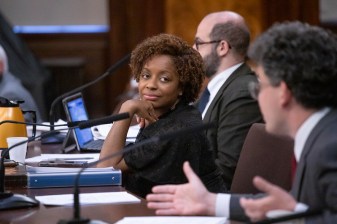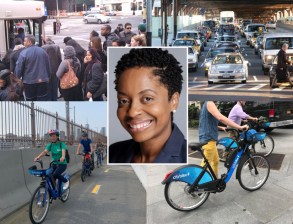Council Transportation Committee Chair Says City Needs More Parking

Will someone think of the cars?
The city should provide motorists with more parking spaces citywide in order to clear bus and bike lanes of illegal parking, the chair of the City Council’s Transportation Committee apparently said on Friday.
“I do think DOT has a responsibility to also ensure that there also is parking, even municipal lots or garages available, as we look to share the street. We’ve got to remember that everyone’s quality of life needs to be taken into account as well,” Council Member Selvena Brooks-Powers (D-Queens) said during a Department of Transportation budget hearing on Friday. “When we see cars blocking bike lanes, bus lanes, that’s really concerning, so I think to be able to move them off the streets, to give them somewhere to go, because the cars have not disappeared, and we may want to wish them away, but that’s not the reality.”
DOT officials pushed back against Brooks-Powers’s concern for car-owners over more vulnerable road users or transit users, given that fewer than 50 percent of New York City households even have access to a car.
“We are changing the culture, teaching people, we have to share the street,” said DOT Commissioner Ydanis Rodriguez. “We share the street for those who need to park, but also the street has be used for pedestrians, cyclists, for open streets, for open restaurants.”
And DOT officials were less-than-subtle in calling out Brooks-Powers’s hypocrisy, given that her own bill would require the DOT to remove parking in order to improve visibility at a minimum of 100 intersections each year — a street safety measure known as daylighting.
“The council has been a leader in asking us to daylight intersections, for example, and that takes away parking, so we have to balance the different priorities,” DOT Executive Deputy Commissioner Paul Ochoa told Brooks-Powers.
Rodriguez also alluded to the difficulty of implementing more street safety measures like bus and bike lanes — as required by city law as part of the streets master plan — when local pols put the brakes on such projects. Among them is Brooks-Powers, who, together with Council Member Nantasha Williams (D-Jamaica), tried to put the kibosh on a pair of parallel busways on Jamaica and Archer avenues in Queens, claiming that the dedicated bus lanes were inconveniencing drivers and hurting businesses’ bottom lines.
Brooks-Powers has also demanded that the city undertake safety redesign of roadways in poor neighborhoods — yet when the city did so on Seagirt Boulevard in her district, she opposed it. Rodriguez may have had that in mind when he said, “We hope as we engage in conversation with all of you 51 council members that we get your support to build the bus lanes, the bike lanes, we need in order to accomplish our street master plan. Many of you have challenges in your own district.”
The exchanges between Brooks-Powers and DOT came amid one of the deadliest years since Vision Zero began in 2014. So far this year, 76 people have died on city streets, including 35 pedestrians and 13 cyclists — ten more cyclists have died so far this year than at this point in 2022, and more than any year since the city started keeping record. And according to a recent report by Transportation Alternatives, Brooks-Powers’s district, District 31, had six deaths, the most fatalities of any Council district in the first quarter of 2023. The district has fewer than 2 percent of all New York City residents, but more than 10 percent of all fatalities.

